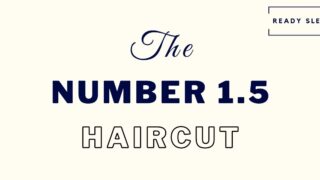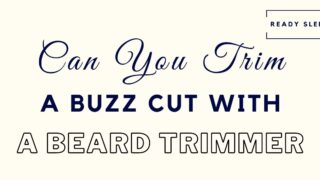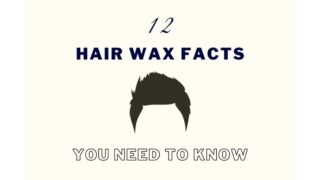Hair that doesn’t play ball has a tendency to ruin the start of any day. It shouldn’t be the case, but it’s the unfortunate truth. So, how exactly do you fix hair that always sticks up?
Growing the hair out longer will often prevent hair from sticking up by causing it to weigh itself down. Blow-drying, using a product with a stronger hold, and styling with the grain can also be helpful.
Although that’s the short answer, there’s more to it.
You’re about to learn some essential tips to prevent hair from always sticking up. But first, it’s important to briefly discuss why it’s happening in the first place.

Why Does Your Hair Always Seem To Stick Up?
One of the main reasons why hair may be sticking up is that it’s cut to an awkward length. It may be too short to lay itself flat or slick back.
Thick hair types are also often more likely to stick up. The dense hair pushes strays and flyaways outward.
Other reasons for hair sticking up include poor washing, poor styling, or simply being cut the wrong way.
Figuring out which of these problems relate to your hair and taking steps to correct them will often fix things.
Sometimes, it may be a case of doing more than one thing to really get on top of it.
Let’s go through some tips you can pick and choose from to find what works for you.
7 Ways To Stop Hair Sticking Up
You’ll notice that the tips in this list all attempt to fix one or more than one of the problems listed above.
1. Grow It Out Longer
Growing your hair longer may be a pretty simple solution. Adding length to hair weighs it down.
At a certain point, it should get long enough to prevent the hair from sticking up and will lay itself flat instead.
You’ve got a few options when growing hair out longer in an attempt to flatten it.
You could simply grow it long enough to weigh itself down; style it forward or to the side. This doesn’t usually require that much additional length – a mere 1 or 2 extra inches may be all that’s required.
Or, you could take the extra step of growing it long enough to slick back.
This usually requires at least 4 to 6 inches of length. In addition, the hair will usually need to be trained to slick back because it isn’t as simple as it may seem.
However, slicking it back is a very effective way to prevent the hair from sticking up once you’ve got enough length to do it.
2. Style With The Grain
To style “with the grain” is to style in the direction of your hair’s growth.
This can vary depending on the part of your hair you’re styling.
For example, the sides usually grow downward. If you’re looking to flatten the hair on the sides of your head, you’ll usually want to style them downward to ensure you’re going with the grain.
However, if you find that your sides actually grow sideways, you’ll want to style in that direction instead if you’re looking to prevent flyaways from sticking up.

The hair on top of your head will usually prefer to lie in one direction or the other. It mainly depends on your parting.
But you’ll find that your hair will naturally fall toward one direction or the other if you were to simply leave it alone.
This is the direction in which it is least likely to stick up.
If you were to style against the grain instead, you’ll find that it sticks up a whole lot more.
So, try to figure out the main directions in which the main parts of your hair grows and always try to style in those directions to reduce the risk of the hair sticking up.
3. Blow Dry
Although blow-drying is mainly known for its ability to add lift and volume, it’s also an incredibly effective way of flattening hair that sticks up.
To do so, you’ll want to blow-dry in your hair’s direction of growth for the same reasons you’d style in the direction of growth.
The heat and pressure from the blow-dryer will make it much more likely the hair stays put for longer periods of time.
Using a concentrator nozzle is especially helpful. It’s a narrow attachment that pops onto the end of the blow-dryer and focuses the heat and pressure onto very specific areas of the hair.
It gives you a lot more control.
For example, if you notice hair seems to always stick up in a specific area, pop on the concentrator nozzle and blow-dry the area in its direction of growth.
The beauty of it is that the narrow concentrator nozzle will allow you to focus the pressure onto that specific area without disturbing the larger surrounding area.
4. Flat Wrapping
Flat-wrapping is a blow-drying technique that also makes use of a brush.
It’s basically just a fancy way of saying you’re brushing while blow-drying, but there’s a little more to it than that.
I’ll start by saying that it’s worth watching a video tutorial of how to do it online before attempting it, as it does need to be done the right way to get the desired effect.
What you’re doing is brushing the hair in its direction of growth while closely following it with a blow-dryer using your other hand.
The two tools need to work in sync with each other. The brush detangles the hair while the blow-dryer locks it in place.
A concentrator nozzle on the blow-dryer is important here because you really need that heat and pressure focused in a more controlled manner.
As always, avoid holding the blow-dryer too close to the hair or your brush. Try to leave at least 7 or 8 inches between them. Excess heat can be damaging, so use a medium heat setting and use a medium pressure.
But flat wrapping in the direction of your hair’s growth could be a very effective way to prevent it from always sticking up.
5. Consider A Messier Style
This might sound strange, but simply choosing a messier hairstyle could prevent hair that always sticks up from looking too obvious.
Although you’re not doing anything to prevent the hair from sticking up in the first place, you are making it appear as though it’s an intentional part of your style.
For example, if you notice that hair keeps sticking up at the left side of your frontal hairline, try styling a quiff that leans toward that side. A messy comb-over could also work here.

So, mess can almost camouflage hair that sticks up.
But the style doesn’t always have to be messy.
Hair that always sticks up at the back is a little trickier to fix because hair tends to grow in all sorts of directions at the crown.
Often, the best thing to do is simply take your time to figure out the different growth directions and carefully work with them to flatten those flyaways.
However, if you wanted to pick a style that simply hid the hairs that stick up at the back, you could try a slick back or even a man bun/top knot if you had the length.
Although these specific styles may not appeal to you directly, the point here is that you can strategically choose a style that masks the appearance of hair that sticks up.
This can be pretty useful if you feel as though you’ve tried the other techniques and aren’t having much luck.
6. Use A Product With A Strong Hold
If you find that hair that you’ve styled seems to stick right back up 30 minutes later, there’s a good chance you’re using the wrong product.
More specifically, there’s a good chance you’re using a product with too weak of a hold for your needs.
This is even more likely if you’ve got especially thick or stubborn hair.
Simply choosing a product with a stronger hold could be enough to prevent hair from sticking up or at least keep it flat for longer periods of time.
The exact product you choose really depends on your needs.
You can broadly split strong hold products into two categories; matte and shiny.
A great matte or low shine product that usually has a strong hold is hair clay. It’s gritty, relatively heavy, and strong.
If you’d prefer a more modern, low-shine, or textured hairstyle, hair clay may be the product for you.
Products with a strong hold and a shiny finish include hair gels and pomades.
Which one you choose depends on your needs.
Hair gels give you a strong and stiff hold, while oil-based pomades give you a strong and pliable hold you can restyle throughout the course of the day.
Oil-based pomades are notoriously difficult to wash out, however, while the water-based gels are incredibly easy to wash out.
So, figure out what type of finish you want and try out a product with a stronger level of hold. There’s a good chance it may just be enough.
7. Try Cutting It Shorter Instead
This may sound like it directly contradicts the very first tip on this list. Well, that’s because it does.
But hear me out.
While growing the hair out longer may be an incredibly effective way to reduce the risk of hair always sticking up, cutting it even shorter could potentially do the exact same thing.
It’s true that short hair sticks up – there’s simply not enough length to make it lay flat.
But it may be so short that the hair that sticks up isn’t even noticeable.
Buzz cuts are the main example of this. It’s unlikely you’d ever look at a short buzz cut and notice that the hair sticks up. It’s simply too short for this to really even be an issue.
All of the hair is ultra-short and cut to a similar length.
But the hair doesn’t even need to be this short to get this effect. If you weren’t keen on an ultra-short induction style buzz cut, try a variation such as a crew cut or a high and tight instead.
This option may not be appealing to some people.
But if you were ever tempted by these short, low-maintenance hairstyles, knowing that it would reduce the appearance of your hair sticking up may be enough to make you try them out.
Conclusion
Most of the tips focus on working with hair that sticks up instead of trying to fight it. Getting to the bottom of why it’s happening with your specific hair is the first step.
Then, try out the tips you think would help.
Enjoy.
Ready Sleek founder. Obsessed with casual style and the minimalist approach to building a highly functional wardrobe. Also a fan of classic, vintage hairstyles.







